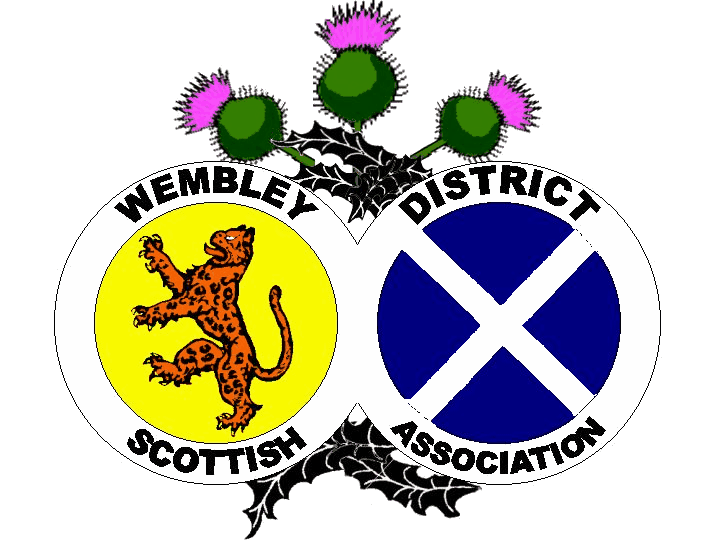 History
History History
History
Rolls of Honour
Extracts from the Association's minutes included below are shown in italics

A Council Meeting circa 1999
An Association is Born
On 2nd June 1932 a meeting took place of several Scottish members of the Wembley Bowling Club with the stated intention "that it was desirous to have a Scottish [sic] in Wembley." Temporary officers were appointed "pro tem for the purpose of furthering the project" and on 5th October 1932 the first Annual General Meeting was held at Lealleys Rooms, High Road and attended by about 70 members. "Various Speakers voiced their opinion that the Association should be constituted forthwith and this became unanimous finding of the meeting."
Early Activities
For the initial season the new council organised "the holding of the four Scottish Festivals viz"
Halloween Gathering for which 95 tickets were sold. It had been arranged for "Miss Scott to act as pianist and singer, while probably a violinist would also be in attendance at an inclusive fee of 10/-......Mr John Eadie and Jimmie Weir, would also be glad to contribute to the evening's harmony......J Atholl Robertson had consented to attend and spin a few Scottish stories".
St Andrews Whist Drive. Accommodation was limited to 30 tables at the Wembley Institute Hall which cost £1 10/- to rent for the evening. Various members "intimated their desire to give prizes for the drive.....and a prize of 1 Doz of Eggs for longest sitter to be purchased by Secy".
Hogmanay Social with a number of musical items was held in the Cafe at the Wembley Baths at a rent of £2-2-0d."The balance sheet as produced showed Receipts and Expenses to balance. This was considered very satisfactory given the various other attractions that evening."
Burns Nicht was held at the rooms of the Express Dairy Co, who provided refreshments at 1/- per head. The evening's entertainment was arranged "with the L.M.S. Railway..... providing lantern slides, Lecture and Lecturer of Burns Country for this occasion. It was pleasing to know that they agreed to lend these free of charge." Curiously "Miss Scott to be asked as accompanist and to sing during the lecture if necessary"! The event was generating a lot of interest and it was expected that "a company of between 180 and 190 might be given to the Express Dairy for catering." Ultimately this event showed a profit of 14/6d.
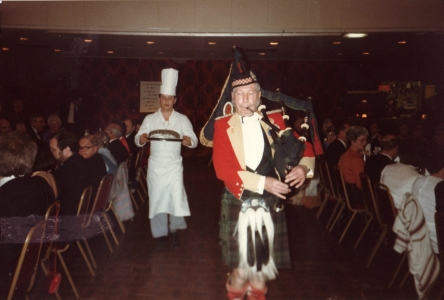
Piper and Ex-President Charles Bogart pipes in the Haggis - Burns Night c1986
At the end of 1932 the number of fully paid up members had reached 132.
Additional events for the 1933/34 season were "A Trip up the River and Back from Richmond Pier", "A Motor Run through Herts and Bucks Including a visit to St Albans" and two Whist drives, the St Andrews night function now becoming a formal Dinner and Dance.
Death of a Monarch
On 21st January 1936 a "hastily summoned meeting of the Council met at Mitchells Restaurant.......in view of the tragic suddeness [sic] of King George's death and to consider the desirability of cancelling the Burns Social on Saturday 25th." The event was duly cancelled and "the President moved that this meeting record in their minutes their deepest regret at the death of their beloved King. He was sure he voiced the feelings of every member of the Association in thus paying tribute to a great ruler. He would like also to record their deepest sympathy with the Queen and all members of the Royal Family. He was sure the loyalty of the Association, given to the late King, would be extended to King Edward VIII on his ascending the Throne. God Save The King."
The Association at War
"A meeting of the emergency Council, the first since war started, was held at Terry's Cafe on Wednesday 22nd November 1939........The meeting then discussed future socials. It was felt that something should be done if the members were to be kept together, and that a dance should be held at Terry's on St Andrews.....It was agreed to recommend [at the AGM] that the Tuesday evening dances be resumed........a Children's Party was cancelled for this year."
At the AGM on 26th March 1940 it was "suggested that in the present circumstances the council should be re-elected en bloc......After a free exchange of views this found favour with the meeting......[It was] thereupon moved, that the present council continues in office until such time as circumstances warrant a change." It was further agreed to continue the Tuesday dance classes (under the instruction of Mr Jack McConnachie) and "to wave[sic] the condition meantime where members were allowed to bring only one friend. No distinction to be made to number of friends." Three whist drives and "a Sunday outing by Motor Coach" were also arranged for the 1940/1941 season. However by April 1940 the Sunday outing had been postponed and it never took place.
In 1941 the AGM had been moved to 3pm on Saturday 1st March 1941 (probably due to the nightly bombing raids during this time). The meeting "agreed, should circumstances permit, to hold social events and dancing every alternate Saturday afternoon commencing October next." The meeting closed and "dancing was afterwards enjoyed to music supplied by Piper Jim Flett, and so ended a happy meeting, held in very trying circumstances, with the earnest wish that when we meet again the war will be over and peace reign again".
In 1942 the AGM and dance classes moved from Terry's Cafe to the Wembley Institute in London Road which continued to be the Association's main location until June 1984.
By September 1944 the situation had improved sufficiently for the Council to "resume the evening dances on Saturday 14th October and hold same every alternate Saturday until the AGM in March." The same meeting agreed to hold a Victory Ball "on the Saturday after hostilities had ceased against Germany."
All in all the Association survived the war in good order. In the Secretary's Report for 1945/1946 he says: "In the first place, Peace has at last come to a troubled world, and my earnest hope is that never again shall we and those who come after us be asked again to undergo such a terrible time. Secondly, your Association is now in a stronger condition than ever it was. The year just ended has been a record one. The membership, 149, is certainly very good and the financial statement proves the hearty support given to all our functions."
From Strength to Strength
The next decade saw the Association expand it's membership and programme of events. By the 1954/1955 season there were 6 life members, 176 paid-up ordinary members and 14 junior members. Additionally there were 75 members whose subscriptions were in arrears. A busy calendar included 12 social dances held at the Wembley institute with an average attendance of around 80, six larger functions (including the 4 original festivals) with up to 144 people and The Town Hall Ball attended by 330 dancers (though this number had exceeded 500 in 1951 and 1952, the decrease in numbers being "due mainly to the non-attendance of certain Societies which normally give their support. These Societies unfortunately had functions on or near the date of the ball."). The balance sheet shows the association with total assets of £414 16/-.
Scottish Country Dancing
At the council meeting on 15th February 1933 "it was suggested that should a sufficient number come forward a Dancing Class be organised". The syllabus for 1933/1934 states that dancing "Classes for juveniles and adults will be arranged at Union Hall, Ealing Road, commencing on Tuesday evening 10th October 1933. Mrs Chambers and Miss J.K. Grant have been appointed dance conveners and those desirous of enrolling should at once forward their names to either of them. The fee for a three months session will be: Adults £1 1/-. Juveniles under 16, 10/6d." The first instructor was to be Pipe Major Taylor "whose fee was £1.11.6d per evening, and that he was prepared to come for one night and if sufficient numbers did not warrant continuing, the classes to be stopped - Miss Grant agreed to get Miss Clark to act as pianist at a fee of 5/- per night." The first Class was duly held on Tuesday 10th October 1933 and by the end of the first month were "showing a loss of 14/6. It was agreed to carry on, in the hope that there may be an influx of numbers." By the following month however things had improved and "showed a balance in hand of £1-2-6. Considerable discussion ensued as to making a reduction in price. Ultimately it was agreed to charge Juveniles 1/- and Adults 1/6 each per evening." The mood of optimism was short-lived. At the council meeting on 11th December 1933, following the end of the first session of classes, the deficit had returned and was now "approximately £6 up to that date.....The President thought that the Association had now done enough and that the classes should cease, unless they were to be self-supporting. The Vice-President was anxious that the classes should be carried on.......ultimately the Secretary moved........that the classes be continued as formerly, with a reduction of the instructor's fee [to £1 1/-] which was seconded by Miss Grant." This proposal was carried with the classes "commencing on 9 January 1934 for one month." From this rocky beginning the class became a cornerstone of the Association's activities. In September 1934 "the Secretary was instructed to engage the Union [hall] as from Tuesday 2nd October. He explained that he had already seen Mr Haberland who was again agreeable to act as pianist." By October the finances had improved enough to consider "that should there be any surplus over after paying all expenses, he [Major Taylor] should be paid up to £1-11-6 per night."
Major Taylor was the first of many instructors to serve the Association. Others include Jim Flett, Jack McConnachie, Doris Anderson, Alistair Rose, Miss B. Green, Mr J. McLachlan, Mrs J.G. Johnson, Lorna Reekie, John McMenaman, Rita Marlow and Mrs Gillian Collis. Our current teachers, Graham & Caroline Hamilton, have been in charge of the dance class since 2008.
By 1936 five of the Association's major functions were classed as dances, including three of the four major festivities ("A Nicht Wi' Burns" being the other). An annual Dinner and Dance was held in February and each September there was a "Flannel Dance". Unfortunately there is no information on the format of the evening though it is probable that the name implied a less formal evening than the other dances and festivals. It was obviously successful because it remained in the Syllabus up to the start of the War.
Town Hall Ball
It had long been an ambition of the Association to hold a Ball at Wembley, now Brent Town Hall. A Joint Dance with Harrow Caledonians was discussed in 1946 but it was felt that "the two societies would not be able to raise an attendance sufficient to make it a success in Wembley Town Hall." The following year the Association planned to hold a Town Hall Dance on their own but "in view of the present crisis and the necessary cuts in petrol, many would be deprived of attending and it would be advisable to cancel it until more prosperous times." In 1949 a sub-committee was formed to arrange a Town Hall Ball to be held on Thursday 16th March 1950. They got as far as arranging "to get in touch with Mr McBain for 10 performers keeping in mind question of minimum charge as prescribed by Musician's Union. To write to Captain Glover enquiring about the Pipe Band of the London Scottish......write to Mr Peter Sinclair, Cock of the North, as to whether he would contribute to the evening's enjoyment". However on 8th December 1949 a letter was received from the entertainment manager at the Town Hall which stated that "in view of the forthcoming Parliamentary General Election, Wembley Council had considered the letting of the Assembley Hall. As the Hall and Refreshment Annexe would be required for Polling purposes, should the Election fall on the Thursday allocated for our Ball, we would require to relinquish same." The Ball was once again cancelled (the election was actually held on 23rd February and Wembley returned two Conservative MPs, Labour winning a narrow majority of 5 seats in the House of Commons). Finally, on 22nd February 1951 the first Wembley Ball, in the presence of the Mayor, was held in Wembley Town Hall. 600 dancers had attended, the nett profit being £50-3-9d. The last ball to be held at Brent Town Hall was in 1992.
Musicians
Many musicians and bands have performed for the Association over the years. From the inception of the Association Mr Haberland was employed to play the piano at some of the social dances as well playing piano for the class and providing a band for some of the larger festivities. For the Hallowe'en festival in 1946 he was "engaged with at least 3 of a band and that they must stop [stay] until the conclusion of the festivities." However on this occasion "the band particularly did not meet with approval - the use of a saxophone to Scottish dances being detrimental....It was resolved to have a talk with Mr Haberland and request his personal attendance - if possible - at all our functions and that a violin be substituted for the Saxophone." He retired in 1954 and was awarded Life Membership for his 21 years of service to the Association.
McBains Band first played for the Association in 1947 and "much of the success of the evening being due to the music supplied by McBain's Highland Band". Other bands over the years have included the Jean Murray Scotts Dance Band, Blue Bonnets, the Murray Pride, Alan Humberstone, Flora Argent, Fraser's Scottish Dance Band, Bobby Morton, Stan Watts, Brian Hamilton, Frank Reid, Kafoozalum, Ian Muir (Prestwick), Jim Lindsay and the Craigellachie Bands.
Groups and Sections
The first specialist group within the Association was a Dramatic section which was first suggested at the council meeting of 27th March 1943. Due to initial problems with finding suitable halls in which to perform, the section took some years to really get going. By 1947 it was reformed as the Dramatic and Literary Section and performed it's first major production at St Andrew's Hall, Ealing Road on 14th February 1948. "On the whole it was a magnificent show and all acquitted themselves very well indeed." Unfortunately the name of this play is not recorded but in March 1950 a production of "Candied Peel" was performed and "showed a profit of £3. This was considered very satisfactory". However the financial success of this performance led to tax complications and, after discussion with HM Commissioners of Customs and Excise and the London Scottish Drama Guild it was proposed that the section be constituted as a financially independent group within the Association. A choir had been formed in November 1948 and these two sections together became The Drama and Music Group on 25th May 1950, their first production being the three act play "Key to the Door" performed on 10th February 1951 which was "commended not only domestically but also in the local Press." The choir was experiencing similar popularity with 29 singing members and two major concerts a year as well as performances at various Association functions. So successful and diverse were these activities becoming that the group split on 26th June 1951. The Drama Group continued to be active until 1956 but by that time it "suffered very considerably through lack of support and had a very hard struggle to keep things going this year". Despite an appeal for additional members the group had lapsed into inactivity with the last production being held on 8th December 1956 and was formally disbanded on 11th July 1967. The Music Group was faring somewhat better and continued as a Ladies Choir until 1996. A typical annual programme from 1976 included entertaining at "Woodlands, Whyteways, Robert's Court and Priory Close, Harrow Blind School, Wembley Blind Social Club [and] Ealing Blind Social Club" in addition to performing at the Association's musical evening and Christmas Revels.

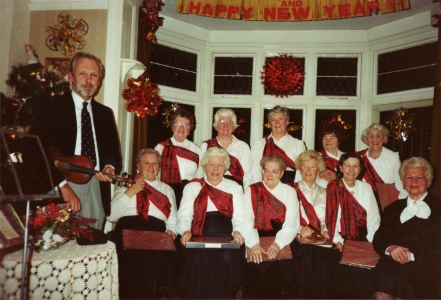
The Ladies Choir performing at Christmas Revels c1990 and at the Charles Goddard House, Wembley - Christmas 1993
At the AGM in May 1952, in an echo of the roots of the Association, a Bowls Section was proposed to field a team in the local Weir Cup which they continued to enter until 1956.
First mooted at the AGM on 31st May 1961 the first Literary evening was arranged for 24th October and the Group was formally constituted at the council meeting on 15th May 1962. The object of the group was "to promote and stimulate an interest in all things Scottish - literary, historical and geographical - fostering Scottish traditions and customs within the parent Association" . Activities such as historical lectures, play readings, mock trials and slide shows were all arranged but numbers had dropped so low that the Group was disbanded in February 1965.
In 1962 Piper Mr Tommy McGowan started a general piping class for all ages - its students included "little girls, youths and a lady."! By 1963 it had been fully constituted as a Group. In the early days the only equipment the group possessed were chanters with no full sets of bagpipes but as the group prospered the Association was eventually able to obtain two sets for use by the class. In 1972 Mr Chas Bogart took over as tutor and by 1975 Mr Harry Adderley was in charge and the classes continued until the 1978/1979 season.
In the early 1960s a series of Young Scots nights were organised to attract younger people to the association. From these events a formal Section was formed in October 1962 with Mr A.A. Pow Jnr as Chairman. "The age group was to be between 14 and 25......The two Young Scots Nights on the syllabus would be organised by the [Young Scots] Committee. It was also hoped that modern records would be played during the interval on the Institute nights so that young people could jive if they wished." By the AGM in 1963 the "section was now proving very successful. They had table tennis and other indoor games besides dancing" . However a note of caution was sounded at the same meeting as the President "was disappointed that the older members and young members did not mix very well on the Young Scots nights at the Institute". This very quickly became a serious issue and attendances at the Young Scots meetings had fallen so low by the AGM the following year that "the group had been forced to give up.....through finance, that is, the charge made to members of which there was only 8 regular attenders did not even cover the hire of the hall which was £1.0.0" Despite various discussions taking place over the next couple of years the Section was never reformed.
At the AGM in 1962 the dance class organiser, Miss Reekie, "said the time had come to consider making the Dance Class into a Group with an allowance rather than having to ask for money." After some discussion a distinction was drawn between the Dance Class and a Dance Team and a proposal was carried granting "an allowance of up to £10.0.0d provided that it [A Dance Team] becomes a Constituted Group". The Group was so successful that by the AGM in 1963 it was self-supporting and the allowance was returned to the Association. "They had attended various charity functions, giving demonstrations, entertained old folks etc. and had been most welcome wherever they went. They had taken part in the Highland Gathering of the Festival of Scotland on 11th May and been placed fourth in the open event." By the AGM on 5th June 1964 the group appeared to be in good order - "the standard of dancing had improved thanks to Mr Jack McConachie and Miss Lorna Reekie. A number of displays had been given to various organisations..........A number of the Group had obtained the Imperial School of Scottish Dancing's Bronze Medal and honour markings were awarded to two members." and the Group was "congratulated for their enthusiasm" to which the entire meeting were in favour. However all was not well and at the very next Council meeting on 23rd June 1964 it was proposed that "representatives from the Council should meet the committee of the Dance Teams Group to discuss difficulties". These appear to centre around the logistics of running two separate dancing groups and the meeting of representatives was duly held on the 13th October 1964 where it was recommended that "A co-ordinating committee could be considered, consisting of members of the committees of both classes, with instructors, to meet regularly to discuss the progress of both classes, to give help where needed, to exchange ideas and make recommendations for the improvement and general welfare of the dancing classes and to report monthly to the Council." However, "The Dance Team Group did not wish to sit on a joint committee because they did not feel it necessary." The Council pressed the matter however and they received a reply stating that "the Dance Teams Group definitely do not wish to join the proposed committee, and further that the Dance Teams Group will disband as from 19th January 1965". Dance demonstrations were to continue but "the dancers would work as individual members of the Association" an arrangement that continues to this day.
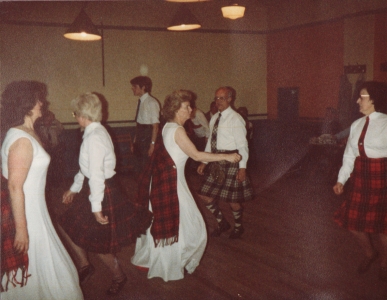
The demonstration team at The Wembley Institute c1982
In 1999 and 2000 the Association was invited to take part in a Scottish Tattoo at the Royal Albert Hall, organised by Ian McLennan.
Changing Times
The 1950s and 60s were a boom time for the Association. The membership peaked in 1955 at 177 members and 15 juniors. By 1969 this had dropped to 115 members and 9 juniors. With the 1970s, and an ever increasing diversity of leisure activities to distract potential members, numbers slipped into a gradual and steady decline. By 1980 there were 96 members; by 1990 only 68 and at the turn of the new millennium only 34 paid up members were left. The syllabus had likewise been trimmed back. In the 1968/1969 season there were three of the four original festivals left (Hogmanay being the one missing). There were also 7 dances, 7 Bingo evenings, 7 Whist drives, 2 Children's parties and the Town Hall Ball.
By 1993 there was only Hallowe'en, Hogmanay (now both much smaller party events), Christmas Revels, Burns Night and the Annual Ball (no longer at the Town Hall).
For the current season (2007/2008) the syllabus shows 6 Monday socials, the Annual Ball, Burns Night and a summer meal out.
Of all the events only Burns Night has survived in its original format. Although numbers have reduced to around 70 each year, the event is still a formal Dinner Dance with the Address to the Haggis, speeches, singing and dancing to live music at Northwood Golf Club.
The Ball is now held at Kodak's Eastmans Hall in Harrow. It also attracts around 70 people and although there are no longer the original formalities such as entertaining the Mayor and Presidents from visiting societies, the function is still a highlight in the Association's calendar.
The dance class has also shrunk in numbers and now our dance class each Monday has about 20 to 30 attendees each week. However they are still enjoyable and friendly affairs and the cornerstone of an Association that has survived and adapted to suit the pressures and demands of a changing world.
75 not Out
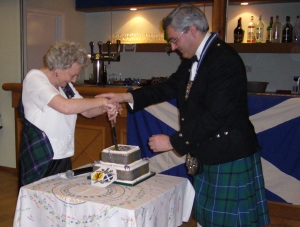
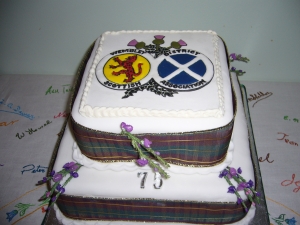
The Association celebrated its 75th Anniversary with a special ceremony at The Annual Ball on 24th February 2007 at Eastman's Hall, Kodak in Harrow. The incumbent President, Graham Ivory, and the most senior Past President present, Gillian Collis, cut a cake made by another past president Sheila Cottrell. The cake was presented on a tablecloth which had been commissioned for the Golden Jubilee in 1982 and is embroidered with the signatures of everyone who was a member of the Association at that time. The cloth was updated in 2007 to include those members who had joined since 1982.
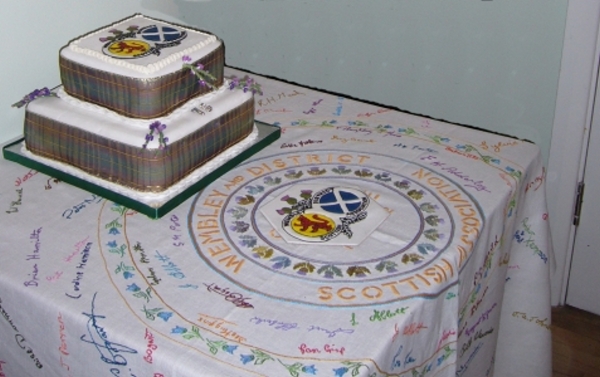
80th Anniversary Celebrations
On Monday October 8th 2012 the Association held a social dance to celebrate 80 years since the Association was first constituted. All dances had a reel of three or figure of eight followed by a circle or chase thus depicting "80" in dance formations and during the interval, nibbles, cake and Cava were served. A perfect start to our Anniversary season.
The President with the cake-maker, Caroline Hamilton
End of An Era
At the AGM on 1st June 2015, our secretary Pam Crisp retired after more than 3 decades in the post. In her first secretary's report on succeeding Pam, Caroline Hamilton wrote:
"Pam first took on the role of secretary in 1982 and has served longer than any other secretary since the founding of the Association. During that time she has also been Vice-President and President twice. A society cannot function without a strong and efficient secretary and the healthy state of the Association is due in large part to Pamís hard work over such a long period."
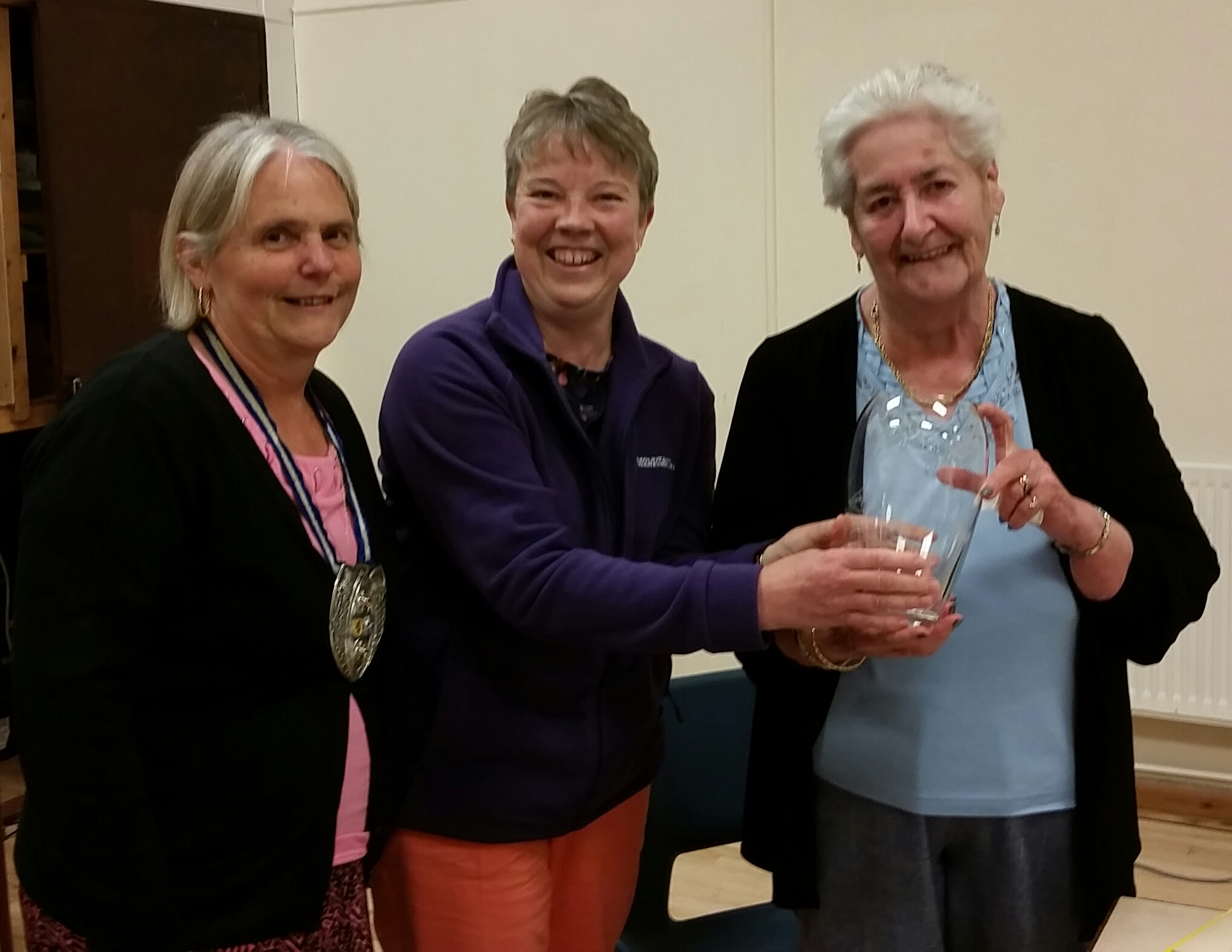
The President and the new secretary present Pam with an engraved vase to mark her 33 years of service.
Suspension of Activities
On Monday 16th March 2020 the Association held it's Spring Social. At the end of the evening and with the world under threat of COVID-19, a new and unprecidented pandemic, everyone said their goodbyes unsure of when we would be able to meet up and dance again. Even the most pessimistic amongst us would have been shocked if we had known then that nearly 18 months would pass before we would dance again. Even without being able to meet up, the Association kept going by holding weekly "Virtual Dance Classes" via Zoom on-line meetings. Every week, Graham and Caroline Hamilton would set a different themed quiz. A few examples were "The World Cup of Dances", "Dancersmash", "Name that Tune" and Dance Scottish That Name - the last one being a competition to name a dance having watched a video of it being danced backwards! In between each quiz question, everyone had a chance to chat and relate what they had been up to during lockdown.
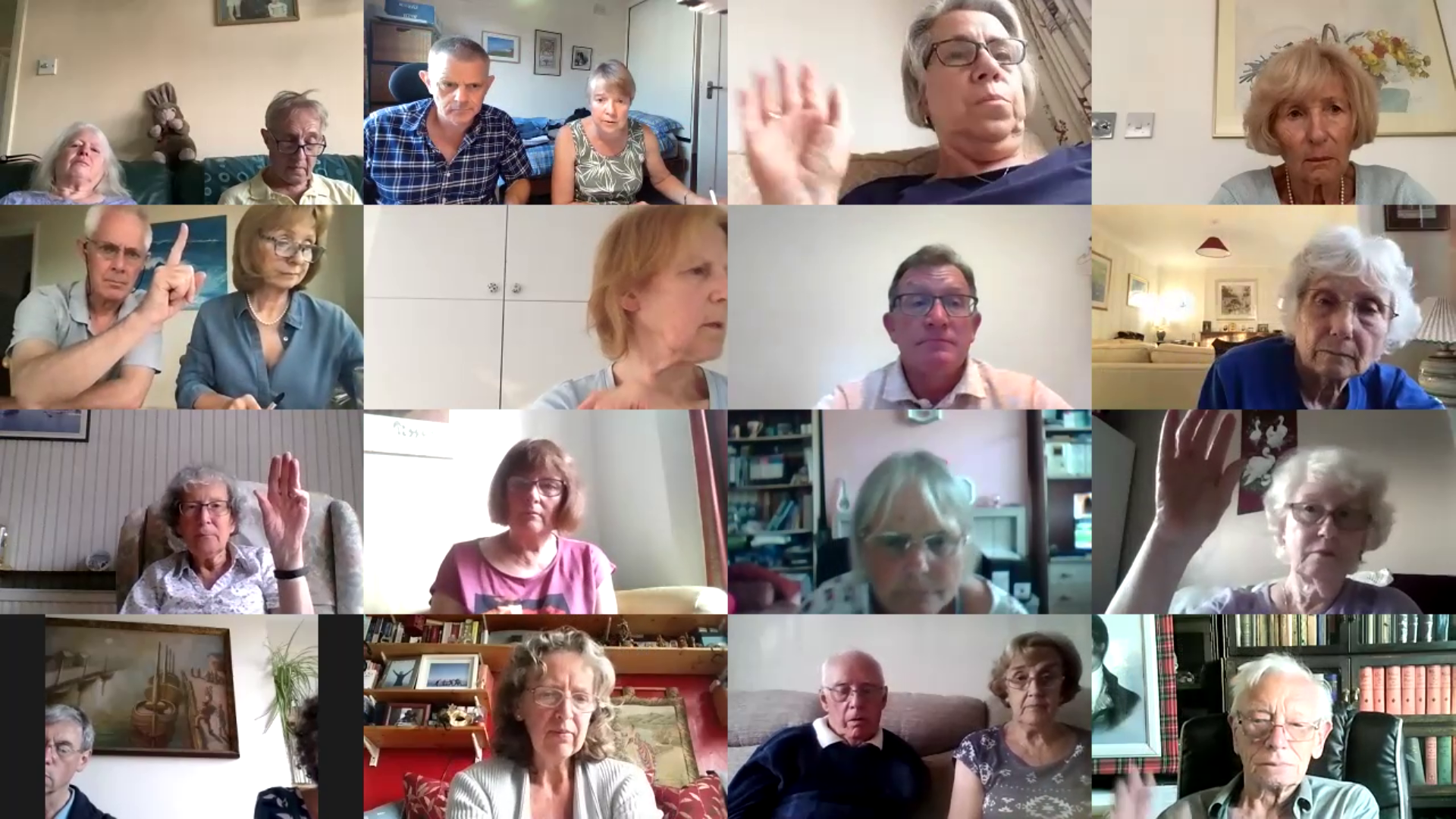
The 2021 AGM was held via Zoom
On Monday July 5th 2021, with the majority of the country having been double-vaccinated, we were able to hold an end-of-season meal at Northwood Golf Club and finally meet up again in person. Two months later, on Monday 6th September 2021 our dance class resumed and the Association was up and running again.
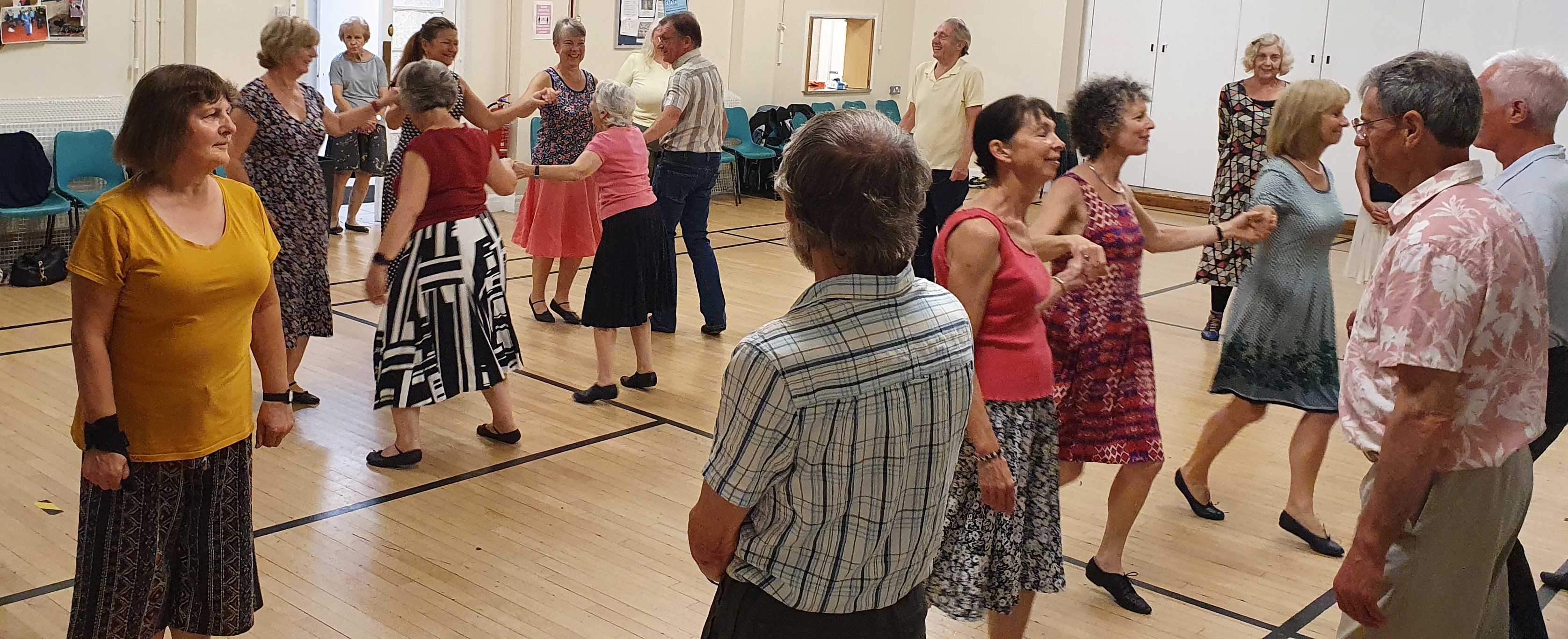
The First Dance Class back after COVID-19 Lockdowns